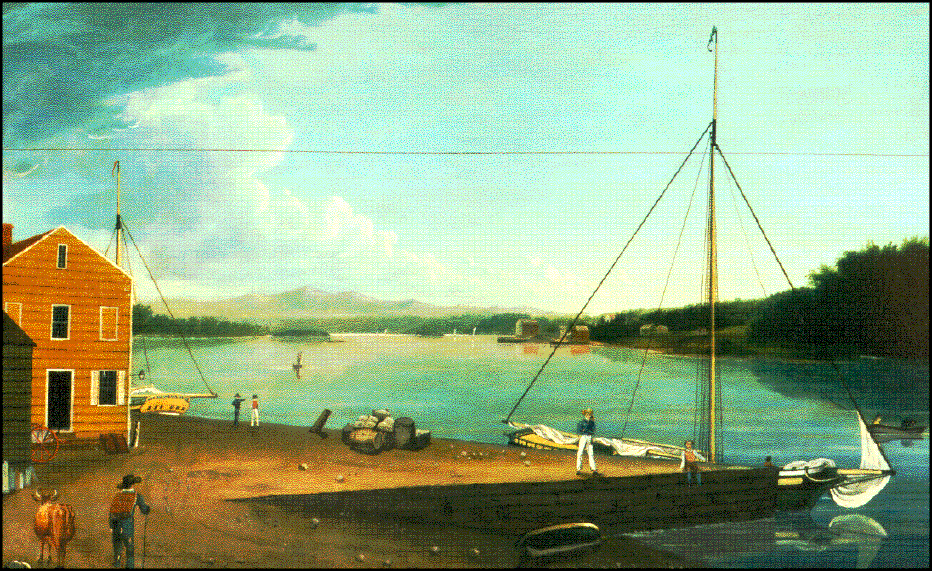
Hudson River
Panorama
A Passage through Time
Tammis K. Groft, et. al.
(Albany Institute of History and Art)

We were forty miles from Albany,
Forget it, I never shall!
What a terrible storm we had one night
On the Erie Canal.Oh, the Erie was rising,
And gin was getting low,
And I scarcely think we'll get a drink
Till we get to Buffalo.The Erie Canal was conceived of in the early years of the 19th century by the usual poltroons and carpetbaggers. One, named DeWitt Clinton, no relation to Chelsea, got the New York State legislature to ante up $7,000,000 to start digging near Troy. They've been digging ever since.The first canal opened the way between Buffalo to Albany, although god knows why the people of Buffalo would ever want to communicate at all with the people of Albany. Later digs extended the canal to Rochester, Attica and Canandaigua.
Hudson River Panorama is a lusciously illustrated volume treating --- mostly --- with the frontage in and around Albany. There are memorable posters of the Palisades, paintings of happy farmers, stereopticon vistas of West Point, engravings of tattooed Maqua indians, photographs of butter churns (complete with cats and cows), along old plates from the Catskill Mountain House and vistas of the castles of the very rich ... plus several reproductions from the Hudson River School, the river enveloped in mist along with high detail of the tulip trees and the country folk between.
We were loaded down with barley,
We were chuck up full of rye,
And the captain, he looked at me
With his gol-durn wicked eye.Oh, the Erie was rising,
And gin was getting low,
And I scarcely think we'll get a drink
Till we get to Buffalo.It is a fine volume with only one problem: the text is so plebeian as to be suffocating.Much is made of the Hudson as a vital portal to mid-American commerce of the 19th century since, before the advent of the railroad, the canal was virtually the only route for grain and foodstuffs between the East Coast and the Middle West. But the authors go all out to squeeze in some not-so-poetic items: the manufacture of stoves is included (Albany was a large stove manufacturing center); space is devoted to the West Albany repair shops of the New York Central Railroad (not illustrated); we also get the manifold building materials out of Peekskill and Sing-Sing (no mention of the facility that made the latter so famous) ... along with details of brickworks, kilns, and cement plants.
Then, there's the Pullman Company,
the largest private employer of black labor in the United States by the 1920s [that] provided African-Americans with stable jobs as waiters and porters on many train lines.
The authors make no note of the working conditions that finally led to the organization of the Brotherhood of Sleeping Car Porters in 1935. It came about, as one historian notes, because "working for the Pullman Company was less glamorous in practice than it appeared from the outside."
Porters were dependent on tips for much of their income; that, in turn, made them dependent on the whims of white passengers, who often referred to all porters as "George," the first name of George Pullman, the founder of the company.
"Porters spent roughly ten percent of their time in unpaid 'preparatory' and 'terminal' set-up and clean-up duties, had to pay for their food, lodging, and uniforms, which might consume half of their wages, and were charged whenever their passengers stole a towel or a water pitcher. Porters could ride at half fare on their days off --- but not on Pullman coaches."We asked a friend who once lived in upper New York State for an explanation of Albany, if it could be explained at all. "One clue," he said, "is that people in Albany install security lights on the house and garage and leave both unlocked." And you know you're in Albany, he concluded, when the people tell you "that they know Dom Perignon. He's a local Mafia leader."
The girls are in the Police Gazette,
The boys are all in jail,
And I'm the only son-of-a-bitch,
Who's left to tell the tale.Oh, the Erie was rising,
And gin was getting low,
And I scarcely think we'll get a drink
Till we get to Buffalo.In the interests of good literature, we must protest the quality of the writing in Hudson River Panorama. It apparently serves only to separate the photographs from the paintings and drawings. For instance, this is commentary on the fecund river art from the late 19th Century: "Other ingredients that helped to pave the way for the success of the Hudson River school included a reasonable transportation system, satisfactory overnight accommodations in the mountains, and guidebooks about how to enjoy the mountains."Artists, at least the artists we know, thrive on being ignored, ridiculed, browbeaten ... being the object of scorn, if not loathing. They do not necessarily seek out "a reasonable transportation system," nor "satisfactory overnight accommodations in the mountains."
Least of all do they need guidebooks on beauty and truth, for they can usually figure these out on their own.
--- Leslie Freeman